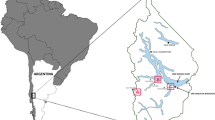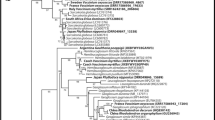Abstract
Through traditional culturing and molecular characterization, we have determined that five putative species and 2 polyphyletic assemblages of fungi produce ericoid mycorrhizae in Gaultheria shallon, other Ericaceae and Epacridaceae. Using phylogenetic analysis of ITS2 sequences in GenBank, we have confirmed that most of these fungi occur in North America, Europe, and Australia. The low recovery rate of culturable ericoid mycorrhizal fungi from Gaultheria shallon may partly be explained by the fact that most mycorrhizal root segments contain an unculturable basidiomycete, revealed by direct amplification, cloning, and sequencing of LSU fungal DNA from root. Molecular characterization and phylogenetic analysis are powerful tools in revealing the geographic distribution and identity of ericoid mycorrhizal fungi.
Similar content being viewed by others
References
Bergero R, Perotto S, Girlanda M, Vidano G and Luppi A M 2000 Ericoid mycorrhizal fungi are common root associates of Mediterranean ectomycorrhizal plants (Quercus ilex). Molecular Ecol. 9, 1639-1649.
Bonfante-Fasolo P 1980 Occurrence of a basidiomycete in living cells of mycorrhizal hair roots of Calluna vulgaris. Trans. British Mycol. Soc. 75, 320-325.
Chambers S M, Liu G and Cairney J W G 2000 ITS rDNA sequence comparison of ericoid mycorrhizal endophytes from Woollsia pungens. Mycol. Res. 104, 168-174.
Chambers S M, Williams P G, Seppelt R D and Cairney J W G 1999 Molecular identification of Hymenoscyphus sp. from rhizoids of the leafy liverwort Cephaloziella exiliflora in Australia and Antarctica. Mycol. Res. 103, 286-288.
Currah R, Niemi M and Huhtinen S 1999 Oidiodendron maius and Scytalidium vaccinii from the mycorrhizas of Ericaceae in northern Finland. Karstenia 39, 65-68.
Daple Y 1989 Ericoid mycorrhizal fungi in the Myxotrichaceae and Gymnoascaceae. New Phytol. 113, 523-527.
Egger K N and Sigler L 1993 Relatedness of the ericoid endophytes Syctalidium vaccinii and Hymenoscyphus ericae inferred from analysis of ribosomal DNA. Mycologia 85, 219-230.
Gernandt D S and Stone J K 1999 Phylogenetic analysis of nuclear ribosomal DNA places the nematode parasite, Drechmeria coniospora, in Clavicipitaceae. Mycologia 91, 993-1000.
Hambleton S, Egger K N and Currah R S 1998 The genus Oidiodendron: Species delimitation and phylogenetic relationships based on nuclear ribosomal DNA analysis. Mycologia 90, 855-870.
Hambleton S, Huhtinen S and Currah R S Hymenoscyphus ericae: A new record from western Canada. Mycol. Res. 103, 1391-1397.
Lee S B and Taylor J W 1990 Isolation of DNA from fungal mycelia and simple spores. In PCR Protocols: A Guide to Methods and Applications. Eds. M A Innis, D H Gelfand, J J Sninsky and T J White. pp 282-287. Academic Press, San Diego.
McLean C B, Cunnington J H and Lawrie A C 1999 Molecular diversity within and between ericoid endophytes from the Ericaceae and Epacridaceae. New Phytol. 144, 351-358.
Monreal M, Berch S M and Berbee M 1999 Molecular diversity of ericoid mycorrhizal fungi. Can. J. Bot. 77, 1580-1594.
Monreal M A 1997 Molecular identification of ericoid mycorrhizal fungi. Ph.D. Thesis. University of British Columbia, Department of Soil Science, Vancouver, BC.
Pearson V and Read D J 1973 The biology of mycorrhiza in the Ericaceae. I. The isolation of the endophyte and synthesis of mycorrhizas in aseptic culture. New Phytol. 72, 371-379.
Perotto S, Actis-Perino E, Perugini J and Bonfante P 1996 Molecular diversity of fungi from ericoid mycorrhizal roots. Molecular Ecol. 5, 123-131.
Prescott C E and Weetman G F 1994 Salal Cedar Hemlock Integrated Research Program: A Synthesis. Faculty of Forestry, University of British Columbia, Vancouver. 85 pp.
Prescott C E 1996 Salal Cedar Hemlock Integrated Research Program. Research Update #1: December 1996. Faculty of Forestry, University of British Columbia, Vancouver, B.C.
Read D J 1983 The biology of mycorrhiza in the Ericales. Can. J. Bot. 61, 985-1004.
Read D J 1996 The structure and function of the ericoid mycorrhizal root. Ann. Bot. 77, 365-374.
Sharples J M, Chambers S M, Meharg A A and Cairney J W G 2000 Genetic diversity of root-associated fungal endophytes from Calluna vulgaris at contrasting field sites. New Phytol. 148, 153-162.
Spatafora J W and Blackwell M 1993 Molecular systematics of unitunicate perithecial ascomycetes: The Clavicipitales-Hypocreales connection. Mycologia 85, 912-922.
Straker C J 1996 Ericoid mycorrhiza: Ecological and host specificity. Mycorrhiza 6, 215-225.
Strandberg M and Johansson M 1999 Uptake of nutrients in Calluna vulgaris seed plants grown with and without mycorrhiza. For. Ecol. Manage. 114, 129-135.
Ursic M and Peterson R L 1997 Morphological and anatomical characterization of ectomycorrhizas and ectendomycorrhizas on Pinus strobus seedlings in a southern Ontario nursery. Can. J. Bot. 75, 2057-2072.
Warcup J H 1988 Mycorrhizal associations of isolates of Sebacina vermifera. New Phytol. 110, 227-232.
Weetman G F, Fournier R, Barker J, Schnorbus-Panozzo E and Germain A 1989 Foliar analysis and response of fertilized chlorotic Sitka spruce plantations on salal-dominated cedar-hemlock cutovers on Vancouver Island. Can. J. For. Res. 19, 1501-1511.
Weiss M and Oberwinkler F 2001 Phylogenetic relationships in Auriculariales and related groups-hypotheses derived from nuclear ribosomal DNA sequences. Mycol. Res. 105, 403-415.
White T J, Bruns T, Lee S and Taylor J 1990 Amplification and direct sequencing of fungal ribosomal RNA genes for phylogenetics. In PCR Protocols: A Guide to Methods and Applications. Eds. M A Innis, D H Gelfand, J J Sninsky and T J White. pp 315-322 Academic Press, San Diego.
Xiao G 1994 The role of root associated fungi in the dominance of salal. Ph.D. Thesis. University of British Columbia, Department of Botany, Vancouver BC.
Xiao G and Berch S M 1995 The ability of known ericoid mycorrhizal fungi to form mycorrhizae with Gaultheria shallon. Mycologia 87, 467-470.
Xiao G and Berch S M 1996 Diversity and abundance of ericoid mycorrhizal fungi of Gaultheria shallon on forest clearcuts. Can. J. Bot. 74, 337-346.
Yamasaki S H, Fyles J W, Egger K N and Titus B D 1998 The effect of Kalmia angustifolia on the growth, nutrition, and ectomycorrhizal symbiont community of black spruce. For. Ecol. Manage. 105, 197-207.
Author information
Authors and Affiliations
Rights and permissions
About this article
Cite this article
Berch, S., Allen, T. & Berbee, M. Molecular detection, community structure and phylogeny of ericoid mycorrhizal fungi. Plant and Soil 244, 55–66 (2002). https://doi.org/10.1023/A:1020291516884
Issue Date:
DOI: https://doi.org/10.1023/A:1020291516884




